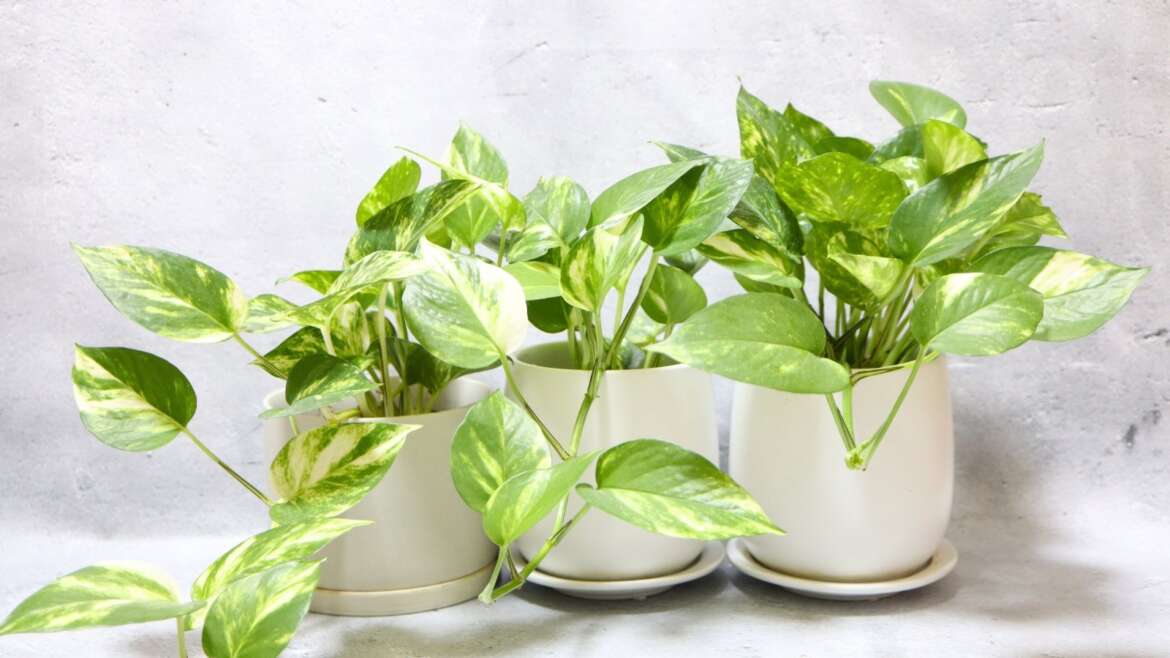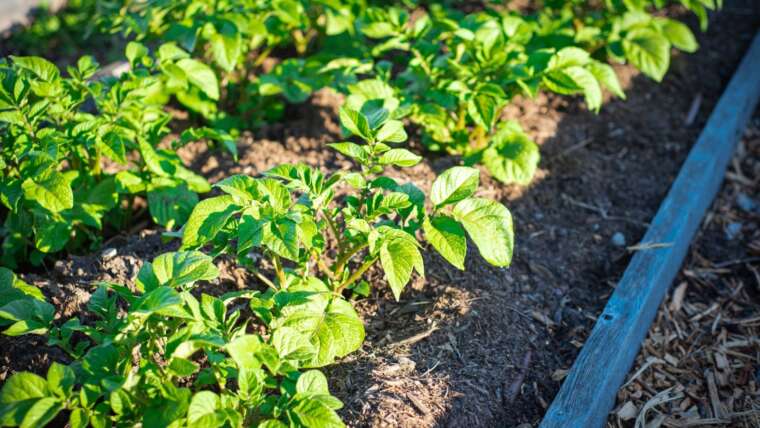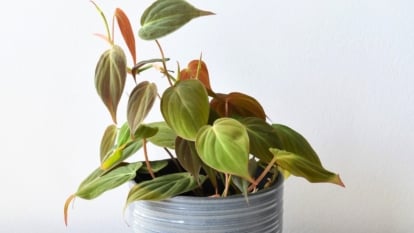Summertime is when our beloved houseplants leaf out and grow into the lush friends we know and love. Being moved outdoors in summer helps them grow thanks to greater light and humidity while adding a tropical flair to your patio, balcony, or backyard. While rains can occasionally help decrease your watering workload, plants need more frequent watering during dry periods.
Let’s back up – what exactly is a houseplant? Houseplants didn’t evolve to live in our homes, of course! Many of the houseplants we know and love evolved to live in the lush, humid understories of the world’s tropics. When we’re able to recreate that environment in our homes or backyards in summer, houseplants thrive!
But before you move anything outside, make sure you have the right growing conditions. Just like people, the harsh rays of the sun can quickly sunburn your plants. Even if your plants grow in full sun in their natural habitats, they still need to acclimate or have protection under a tree or shade cloth. Springtime is also the perfect time to give your plants some TLC before entering their active growing season.
Almost all houseplants benefit from being outdoors, but African violets should be left inside—their growing conditions are so specific that any slight change can wreak havoc. Besides that, here are nine houseplants you should definitely move outside this summer when temperatures drop no lower than 55°F (13°C).
Pothos
Climbing, vining pothos, the trademark houseplant. This is an incredibly forgiving plant and loves to be in the hot, humid outdoors. By the time it’s time to bring your plants in again in the fall, you’ll likely find that your pothos is double its original size.
Summer is also a fantastic time to propagate your pothos plant. This might just be the easiest plant in the world to propagate – simply take a cutting from your existing plant and stick it in a vase or pot of soil. Rooting hormone helps, but in my experience, it’s not necessary for pothos.
Nicknamed “devil’s ivy” for its ease of care and resilience, this is a plant you won’t need to fret over. Keep your pothos plant in the shade, give it a dose of fish emulsion or nitrogen-heavy fertilizer, and be amazed at how quickly it grows.
Croton

Croton is another resilient plant. My old roommate kept hers alive for years in an old container of Cafe Bustelo (sans espresso, of course). They like bright sunlight, but direct light will singe their leaves, so keep this plant under a porch, tree, or shade cloth. Only move your croton outside when temperatures are reliably above 50°F (10°C).
Their colorful foliage adds a pop of color to anywhere it’s kept indoors and will do the same outside. They benefit from a dose of potassium-heavy fertilizer in early spring and again in late spring or early summer as they enter their active growing stage. They need well-draining, slightly acidic soil, so I don’t advise potting your croton in old coffee cans.
Bromeliad

Bromeliads are a huge family of plants, with over 2500 species worldwide spanning over 50 genera. But a few things are generally true amongst this massive plant family. First, they need bright, indirect light to thrive. Second, they thrive in humid, tropical conditions. Many have a central water cup known as a “tank.” All of these factors make bromeliads a plant you should definitely move outside this summer.
These plants draw moisture from two sources: either absorbing it from humid air or storing it in their tanks. When potting them, bear this in mind—choose a well-draining mix like an orchid or specialty bromeliad mix. Avoid potting soil that keeps their roots wet.
The trick here is to mimic their natural environment as best you can. Tillandsia species (including air plants and Spanish moss) absorb moisture from the air, so keep these elevated and away from standing water (in nature, they grow in trees). Whereas scarlet star and blushing bromeliad have central cups to store water, so frequent rains might take care of watering for you. Excepting a few species, such as the pineapple bromeliad, these plants prefer a spot under a tree or shade cloth where the direct sun won’t singe their leaves.
Tropical Begonia

Commonly sold as shade annuals, begonias are famously shade-loving. Though there are some full-sun varieties (wax and fibrous varieties), most houseplant begonias are grown for their showy foliage. Rex begonias are perhaps the most common begonia houseplant, but others include the polka dot and beef steak begonias.
Move your begonias outside when nighttime temperatures fall below 50°F (10°C). As they enter their active growing season, fertilize them with all-purpose houseplant food and topdress the soil with earthworm castings. Keep these plants under shade and bring them in if there is a forecast for high winds.
Tropical Fern

Ferns are a massive plant group – even bigger than bromeliads. In fact, they don’t even belong to a single family, but rather many families. The most common ferns kept as houseplants include Boston ferns, maidenhair ferns, birds’ nest ferns, and many others. What all ferns have in common is their love of shade and humidity.
Some ferns, like the rabbit’s foot fern and the tree fern, have hairs that absorb moisture from the air. Others, like the staghorn fern, are epiphytic and trap water between their fronds. There are too many tropical ferns to list, but don’t move any of them outdoors until nighttime temperatures are reliably above 50°F (10°C). Again – make sure they’re under shade.
Ferns love humidity but generally don’t like wet feet, so they need a well-draining medium. A nursery trick I learned years ago to increase humidity on hot, sunny days is to water the ground. That’s right – the ground – a deck, patio, gravel, whatever you have. By watering the ground where their pots sit, you can make evaporation work in your favor as humidity rises. In a pinch, I also recommend using the mist setting to mist any species with furry stems.
Birds-of-Paradise

Native to South Africa, birds-of-paradise is a common houseplant in cooler zones. In warmer areas of California and Florida, it’s an evergreen perennial. There are five common species of Strelitzia, but whichever variety you have, wait until temperatures are reliably warm to move them outside.
Unlike many houseplants, birds-of-paradise prefer full sun but can survive in partial shade if need be. Full sun and a balanced fertilizer promote the greatest blooms. Birds-of-paradise also respond well to blood meal and manure as fertilizers.
Though they are full sun plants, don’t move them immediately into the sunniest place in your yard! They need time to acclimate over a period of about ten days. The process is similar to hardening off seedlings. Keep your plant in a shady area for a few days, and gradually expose it to more and more light. Morning light tends to be gentlest, so start there and use a timer to expose it to more direct sun in one to two-hour increments. By day ten, your Strelitzia should be ready for full sun, but err on the side of caution – slow is good!
Tropical Palms

Is there a plant more synonymous with the tropics than the palm? Many palms grow well in non-tropical zones, but the varieties we keep as houseplants are the tropical varieties. Some of the most common houseplant palms are ponytail palms, parlor palms, and yucca palms. Sun requirements vary for each plant, but they all love to be outside in the summer.
Summer is also the perfect time to fertilize your palms, but indoor varieties do best with organic fertilizer. They need a fertilizer with a balance of NPK plus magnesium. This should look like two parts nitrogen, three parts potassium, one part magnesium, and one part phosphorus.
Do some research on the type of palm you have. For full-sun species like the dwarf bamboo palm, you’ll want to slowly acclimate them to the sunlight using the same steps as the birds-of-paradise plant.
Peace lily

Native to the understories of rainforests in Central America and Asia, the peace lily plant thrives when set outside for summer. There are dozens of Spathiphyllum varieties, some giant, some variegated, some with pink spathes, all beautiful. The most classic Spathiphyllum is the white-flowered variety contrasting with its broad, deep green leaves.
When temperatures are reliably warm, move them outside. Their large leaves are a dust magnet inside, so hose down the leaves to allow the plant to photosynthesize. They also appreciate being fertilized every two to three weeks during their growing season as they push out new growth. Fish emulsion and organic granulated fertilizers are both great options.
Caring for peace lilies isn’t challenging – they’re dramatic but very forgiving. When thirsty, their leaves droop down theatrically and perk back up like nothing happened hours after watering. My peace lily is known to nearly double in size during hot and humid Atlanta summers under a dense canopy of trees.
Orchids

Believe it or not, orchid plants also enjoy a summer holiday outside. Plants in this family have a reputation for being fussy, but with the right care, they’re surprisingly easy. While many hardy orchid species exist, the ones we keep in our homes originate in sub-tropical and tropical jungles. Some of the common species we see in homes are the moth orchid, cattleya orchid, and dendrobium orchid. In nature, epiphytic orchids like these grow on trees and branches in the tropics, so try to mimic this when putting them outside. Find a nice, shady place and keep them off the ground as much as possible by putting them on shelves, tables, rocks, or even tucking them into a tree.
Fertilization depends on the species and flowering time. These plants generally need a diluted feeding once a month during dormancy and every other week while they’re flowering. You may also need to adjust watering to once or twice a week during long, dry spells.
The biggest issues orchids face outdoors are environmental factors like heavy rain, hail or strong winds, and pests. Control pests by spraying your orchids every three weeks with neem oil or horticultural soap. In the event of extreme weather or your own summer vacation, bring your orchids inside for safekeeping. And, of course, wait until there is no chance of frost before moving them out.
Final Thoughts
When we move houseplants outside, the main challenges are pests, overly dry or wet soil, and temporarily losing some of your indoor decor. Keep an attentive watch over your plants for pests and treat them promptly. If you notice plants getting too wet, cut back on your watering routine or repot them into a well-draining mix.
The list doesn’t end with these plants. The bottom line is that almost any tropical plant will do better in an environment closest to its native zone. The humidity, heat, natural temperature fluctuations, and breeze help them toughen up.
If your plants are big or in heavy pots, don’t be afraid to use a hand truck or enlist the help of a friend! Lift with your legs – your back will thank you.
Your houseplants’ summertime growth will be well worth the wait. When it’s time to move them back inside in the fall, they’ll be healthy and rejuvenated!




